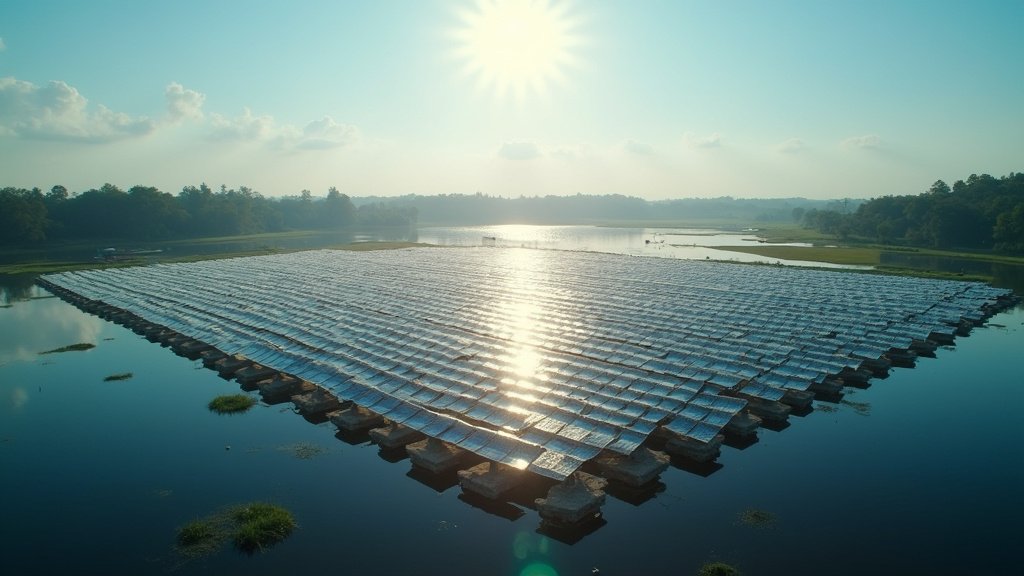India, a nation perpetually balancing the dual demands of burgeoning energy consumption and precious water resources, is witnessing a quiet but profound revolution. At the heart of this transformation are floating solar panels, an innovative approach that is rapidly becoming a cornerstone of the country’s sustainable development agenda. These pioneering installations are not merely generating clean electricity; they are simultaneously addressing a critical environmental challenge by conserving billions of liters of water throughout India, presenting a remarkable dual benefit.
The Dawn of Aquatic Solar Power
The concept of deploying solar panels on water bodies – reservoirs, lakes, and even disused mining ponds – represents a significant leap forward from traditional land-based solar farms. This groundbreaking strategy harnesses the vast, often underutilized surface area of water bodies, transforming them into sites of high-efficiency energy production. The panels, mounted on buoyant platforms, are strategically placed to maximize sunlight absorption while minimizing land footprint, an increasingly vital consideration in densely populated regions. This method ensures sustainable energy generation is not only possible but also scalable, pushing the boundaries of what was once thought achievable in renewable power. The top minds in energy policy and environmental science are keenly observing this paradigm shift, recognizing its potential to reshape the global energy landscape.
Lighting Up Homes, Securing Futures
The immediate and most tangible impact of these floating solar installations is their capacity to provide electricity to homes across India. Regions that once grappled with intermittent power supply or relied heavily on fossil fuel-based generation are now increasingly benefiting from a consistent flow of clean, renewable energy. This direct provision of electricity is making a huge difference in the daily lives of countless people, empowering communities and fostering economic development at a grassroots level. The shift to solar power reduces reliance on traditional energy sources, leading to a significant decrease in carbon emissions and contributing directly to India’s ambitious climate goals. It’s more than just power; it’s about fostering energy independence and improving the quality of life for millions, making a positive impact that resonates across society.
A Liquid Asset: Conserving Billions of Liters
Perhaps the most groundbreaking aspect of this technology, beyond its energy generation capabilities, is its profound effect on water preservation. By covering a portion of the water surface, the floating solar panels significantly reduce evaporation rates. In a country where water scarcity is a persistent threat, especially during prolonged dry spells, preventing the loss of billions of liters of water is an invaluable contribution. This preservation of liquid assets ensures more water is available for agricultural irrigation, potable water supply, and maintaining ecological balance. The innovative approach of combining energy generation with such critical water conservation efforts showcases an integrated environmental strategy that is both elegant and highly effective. This trending news highlights how technology can address multiple complex challenges simultaneously, creating synergistic benefits for the environment and the population.
A Dual Benefit: Energy and Water Security Hand-in-Hand
The intrinsic dual benefit of sustainable energy generation and water preservation embedded in the floating solar panel technology is what truly sets it apart. It’s a holistic solution that addresses two of India’s most pressing developmental challenges concurrently. This strategic fusion provides a powerful model for resource management, demonstrating that energy security and water security need not be mutually exclusive but can, in fact, be mutually reinforcing. This synergy is making a significant positive impact on the nation’s environmental resilience and its journey towards a greener future. All told, the success of these initiatives suggests a viral potential for adoption not just within India, but across other water-stressed and energy-hungry nations globally, making it a topic of great interest in the field of sustainable development.
Paving the Way for a Brighter, Wetter Future
The widespread adoption and proven efficacy of floating solar panels in India underscore a promising path forward. This innovative approach is a testament to human ingenuity in addressing complex environmental and energy dilemmas. By providing electricity to homes and conserving billions of liters of water, these installations are doing more than just powering a nation; they are safeguarding its vital resources for generations to come. The transformative potential of this technology signifies a pivotal moment in India’s sustainability narrative, offering a beacon of hope for a future where energy abundance and water security coexist harmoniously.





